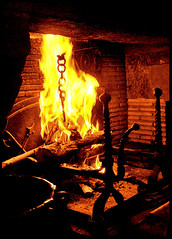- in Green Home by Alexis Rodrigo
- |
- 3 comments
Electric Fireplaces versus Gas versus Wood-Fired Fireplaces
Fireplaces have traditionally been a central part of a home, where family and friends gather to share warmth and stories. Nowadays, we have many options when it comes to fireplaces: electric, gas or the traditional wood. How do you choose which one is best for your home? This article provides and advantages and disadvantages of each kind of fireplace.
If you’re thinking of setting up a fireplace in your home, the first thing to do is determine what its primary purpose is – why do you want it? Are your motivations aesthetic, environmental, financial, or something else? Often, it’s a combination of reasons that motivate people to invest in a fireplace.
Once you have decided how you are going to be using your fireplace, you can evaluate the pros and cons and decide which type is right for you. Here are some of the things to keep in mind when shopping for a fireplace (or keeping/changing the one you have).
1. Electric Fireplaces
Pros: Electric fireplaces are the most inexpensive of all the options. They are convenient; anywhere you have an outlet, you can have an electric fireplace. They are clean, without the mess and hassle of wood, and they come in a variety of designs. For those concerned about safety around fires, electric fireplaces don’t have open flames, making them a safer choice.
Cons: Unfortunately, electric fireplaces look “fake.” There is no flame; only digitalized pictures of flames on certain models. They are a bit like glorified space heaters. And if there is a power outage, there goes your “fire.” It’s not a good option for those who want a fireplace for a back-up heat source, and it uses a fair amount of electricity to run it.
2. Gas Fireplaces
Pros: This is certainly a clean and convenient choice for those who want a “real” flame with the accompanying ambience. Some units have remote controls. Gas fireplaces come in ventless models, which do not use a chimney (thus, more of the heat stays in the house rather than going up the chimney). If you have a wood-burning stove and want to replace it with a gas one, it is easy to insert a gas fireplace into the existing firebox area. There are lots of authentic-looking mantel designs to choose from, too. And if the power goes out, the gas fireplace will still work.
Cons: It’s still not quite a “real” fire, which may or may not bother you – yes, there is an open flame, but there is no pleasant crackling sound to go with it. The ceramic logs should not be burned for more than 3-4 hours, making it a poor choice for meeting long-term heating needs. Unvented models can increase the carbon monoxide present in your home, so you will want to purchase extra carbon monoxide detectors if you go with this option.
3. Wood-fired Fireplaces
Pros: Wood-fired fireplaces do provide a real fire, complete with crackles and pops. Wood-burning inserts or stoves which come out from the wall are excellent sources of heat in the event of a power outage, and can even be used for cooking in a pinch. Firewood is a renewable energy source, and can often be obtained for free. For natural living enthusiasts, building your own fire to warm your home can be personally satisfying.
Cons: You have to buy firewood, and/or cut, stack and haul it yourself. You will need to learn the art of starting a fire (it isn’t easy). Carrying the wood from the woodpile into your house can get tedious during inclement weather and creates mess. The chimney will have to be regularly “swept” or cleaned, and the ashes that accumulate in the fireplace itself will have to be carried out periodically. They can also be fairly expensive. Also, wood fireplaces are outlawed in some areas (like where we live), so check your city’s laws before you install one.
So which fireplace have you decided on? I’m partial to a gas fireplace myself, although my mind isn’t completely made up yet. Share your thoughts by posting a comment below.
![]() photo credit: Marco Fedele
photo credit: Marco Fedele
If you liked this post, submit your email address below to get new posts by email:

